- Submissions

Full Text
Archaeology & Anthropology:Open Access
Occurrence of Archean Iron Bearing Rocks from Babina, Mauranipur and Girar Area of the Bundelkhand Region: As Potential Reserves (SE Siberian Platform)
Singh VK1*, Alexander Slabunov2, Sergei Svetov2, Zoya Rybnikova2, Natalia Nesterova2, Maksim Gogolev2, Oleg Sibelev2 and Neeraj Chaudhary1
1 Department of Geology, Bundelkhand University, India
2 Institute of Geology, Karelian Research Centre, Russia
*Corresponding author: Vinod K Singh, Department of Geology, Bundelkhand University, Jhansi, India
Submission: July 02, 2018;Published: October 17, 2018

ISSN: 2577-1949 Volume3 Issue3
Abstract
The high grade hematite and magnetite iron ores (>56% Fe) are using in India in industry since several years. Due to limitation of the high-grade iron rocks and demand of iron ore for industry, country development; we need to utilize the low grade iron ore. The low-grade banded iron bearing rocks are occurring around Babina, Mauranipur and Girar area in Bundelkhand region may be potential source of iron. The occurrence of Banded Iron Formation rocks and slag heaps, slag waste dumps materials etc. confirm the extraction of iron, copper and gold in these areas by ancestors.
Keywords: BIF; Archean; Bundelkhand craton
Introduction
India is the most important producer of iron ore in the world. Indian production of iron ore constitutes around 10% of the world iron ore output. About 98% consumption of iron ore used in domestic iron & steel, and sponge iron industries. Cement industry is the next major consumer of iron ore. Indian deposits of hematite belong to the Precambrian Iron Ore Series and the ore is limited by banded iron ore formations occurring as massive, laminated, friable and in powdery form. The country has huge reserve of low grade iron ore which should be used due to limited reserve iron ore of high grade. The low grade iron is present in the form of banded iron formations (BIF) all between 35-50% Fe with silica but they are yet to be exploited. The low grade iron ores which contain 45-55% total Fe (Fe2O3+FeO) are found in rocks as banded magnetite quartzite in the Babina, Mauranipur, and Girar areas of Bundelkhand region [1]. Therefore, we discuss the geochemistry of iron ore rocks occur in Bundelkhand craton with their potential uses in the Indian Industry.
Geology of Bundelkhand craton
Figure 1:Geological map of Bundelkhand region (after [1]).
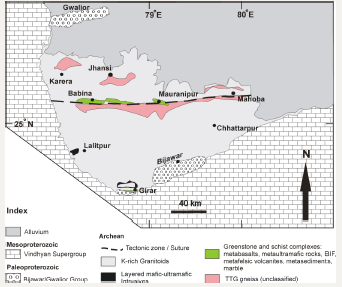
The Bundelkhand region covers 26,000 square km, lying between 24°11’ to 26°27’N and 78°10’ to 81°24’E. The Bundelkhand craton is considered to mostly form during Archean age, with a few relicts of older crust in pool of Neoarchean potash-rich granites, with scattered small enclaves, mainly of BIF, metaultrabasics, rare quartzites, some carbonates and calc-silicates (Figure 1). The BIF in Bundelkhand are of oxide facies with fine laminations and there is no jasper and no immediate association of clastic sediments [2]. The craton mainly consists of granitoids range in age from 3500- 2500Ma and abuts sedimentary rocks of the Vindhyan Supergroup (Neo-proterozoic) to the southeast, south, southwest and west and low grade metamorphic rocks of the Bijawar Group (Palaeoproterozoic) to the south and southeast [2-4].
The post Archean rocks occur as Gwalior and Bijawar Groups were deposited in marginal basin surrounding the Bundelkhand craton. The Bijawar metasediments and mafics are well exposed in south of Lalitpur and south of Chattarpur. The Gwalior basin is located in the northern part of the Bundelkhand craton. The doleritic dyke swarms intruded in Bundelkhand craton, are usually dark greyish green in colour and have NNW-SSE to NW-SE trend [5,6]. A feature of the craton is the presence of parallel quartz reefs that form prominent narrow ridges. These reefs generally trend N35°E - S35°W, are highly jointed, and have a greyish white colour. They have sharp contacts with the enclosing granites and contain many types of ore minerals such as disseminations of pyrite, specular hematite and rarely chalcopyrite. Singh & Slabunov [1,7-9] and Slabunov et al. [10] established two greenstone complexes containing BIF occur in Bundelkhand craon namely Central Bundelkhand greenstone Complex and South Bundelkhand metasedimentary Complex. The Central Bundelkhand Greenstone Complex (CBGC) constitute two greenstone belt i.e. Babina and Mauranipur Greenstone Belts (GB). The Southern Bundelkhand metasedimentary Complex, located in the southern part of the craton, consists generally of metasedimentary rocks of quartzite formations and BIFs. The Mauranipur and Babina greenstone belts represent a tectonic collage. The structure and age of the CBGC has been least thoroughly studied within the craton.
Babina Greenstone belt
The central part of the Bundelkhand craton, contain fragment of BIF, metabasites, felsic volcanic, and these collectively rocks exposed south of Babina town known as Babina greenstone belt (Figure 2). The belt can be traced eastwards for 30km as a fragment of a greenstone belt from Babina to Prithvipur. These, supracrustal sequence consisting of amphibolite schist and BIF rocks which are exposed south of Babina, Pura to Dukwan dam site and extend further east to Mauranipur. The fine grained grey felsic vulcanite has been jointed north of BIF by slip-fault plane and the foliation generally trends E-W. The oldest rocks TTG (3.5Ga; [3]), occur south of supracrustal rocks which not define distinct boundary with it in the field, of light grey colour granodiorite gniesses are exposed 4km south of Babina. It consist three sets of joints and fractures containing numerous pegmatite and epidote veins. Most of the minor shears are filled by recrystallized siliceous material. These phenocrystic, medium and coarse-grained rocks have been metasomatized and intruded by dykes of fine-grained granite, pegmatite, aplite. It is intermixed with pink granite some localities. The pink granite is phenocrystic and medium grained consisting of orthoclase, quartz, microcline and seldom biotite, which also intruded in greenstone rocks.
Figure 2:Geological map of Babina greenstone belt (after [1]).
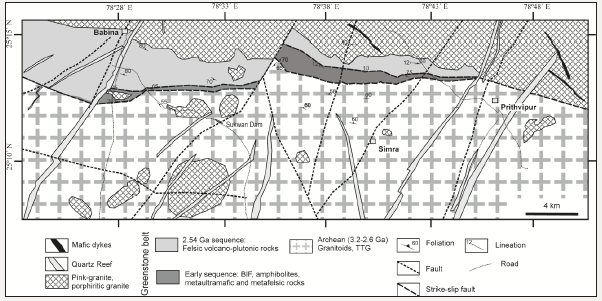
The banding in the gneisses in the Babina GB sector is ESE-WNW trending, with 75° northerly dip. Close isoclinal folds with steep northerly dipping axial planes are found in TTG. Vertically and subhorizontal dipping ductile shear bands, about 0.5 to 3m wide and 100 to 200m long are found in the porphyritic granites [8]. Geochemical evidences of a northerly subductive motion in the craton have been provided by Zainuddin & Mondal [11]. Insignificant migmatites in the craton points to generation of granite magma at great depth rather than fluid-rich quatzo-feldspathic materials. Epigenetic mineralisation is practically absent. Geochemical characteristics of the granites [12] point to minimal crustal contamination. Due to intrusion of pink granite in earlier formed TTG, BIF and Felsic volcanic rocks, produce complex outcrop difficult to mapping of the greenstone belts of Bundelkhand region.
Mauranipur greenstone belt
In Mauranipur area, small bodies of folded and banded BIF are widely exposed near Baragaon, Ras Pahari villages and Kamla Sagar Dam (Figure 3). The komatiite, basalts, metabasites, felsic volcanic are other rock types also occur in the belt. The detail geology and tectonics setting of the belt have described by Malviya et al. [13], Singh & Singh [14], Slabunov & Singh [15,16] and Singh et al. [17]. The CBGC generally consists of three stratotectonic associations:
Figure 3:Geological map of Mauranipur area.
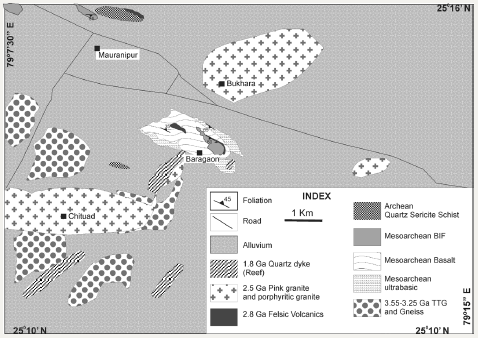
1. A Paleo-Mesoarchean basalt-komatiite association (in the Babina area this unit has only preserved as small lens-shaped bodies).
2. Mesoarchean an iron formation association (BIF)
3. A Neoarchean dacite-rhyolite association (Felsic Volcanic).
The basic-ultrabasic, rhyolitic-dacitic, and banded iron formation (BIF) units consider as early assemblage and the late assemblage consist of a Neoarchean felsic volcanic unit. The contacts between the units and assemblages are tectonic in field. Epidote-quartz-plagioclase metasomatic rocks are formed locally in the contact zones [16]. The age of felsic volcanics from early assemblage of Mauranipur greenstone belt is estimated at 2813±20Ma. There is an inherited Zr which is dated at 3242±65Ma. It is deduced as the first subduction volcanism during the Mesoarchean in Bundelkhand craton. The late felsic volcanics, occurring as subvolcanic bodies, were identified in the Mauranipur greenstone belt. U-Pb isotopic age analyses of the late felsic volcanics found ~2864±46 Ma and 2557±33Ma. The early age of zircon are interpreted as xenogenic volcanics trapped from enclosing rock. The later age of zircons are assumed to reflect the timing of felsic volcanism during the Neoarchean. The similar felsic volcanism occurs during 2542±17Ma in Babina belt. The Neoarchean felsic volcanics from the CBGC are enriched in Sr and Ba and depleted in Cr and Ni in geochemical characteristics than early (Mesoarchean) felsic volcanics. The Neoarchean (late) felsic volcanics were formed in a subduction geodynamic setting in an active continental margin.
Girar schist/ Metasedimentary belt
In southern part of Girar and Baraitha, Quartzite and BIFs rocks are well exposed. The Berwar formation (Mehroni group; [18,19]) is comprised of a sequence of quartzites-conglomerates and banded iron quartzites overlain by dolomites and chloritic slates (Figure 4) [20]. The section belongs approximately 150 meters wide. The metasediments are cut by dykes of pegmatite/ granites and dolerite. The detail geology of the area is described by Singh & Slabunov [7] and Slabunov et al. [20].
Figure 4:Geological map of Girar area (after [7,20]).
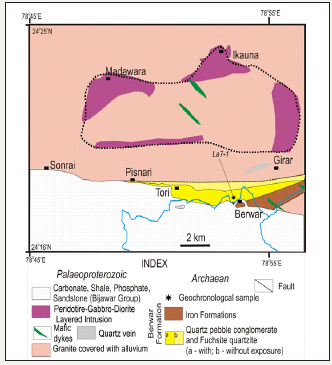
Geodynamic Evolution
There are two main geodynamic setting for BIF fomed in Bundelkhande craton. First episode are Mesoarchean in subduction setting. BIF of Babina belt forms seems in forearc basin under felsic and mafic volcanic control. BIF from Mauranipur belt forms in backarc basin. The mafic-ultramafic and early felsic volcanic forms in this geodynamic system too. Neoarchean BIF from Girar belt forms in basin with plume control like as Ikauna dunite-pyroxenitegabbro layered complex [20]. Neoarchean Felsic volcanics occur in Babina and Mauranipur greenstone belts, generally as fine-grained schists with porphyric quartz, albite and microcline. Felsic volcanics from the Babina belt are classified as dacites, less commonly as calc-alkaline rhyolites. The geochemical characteristics of this felsic volcanics indicated that they form in a subduction setting in active continental margins. The TTG is normally formed by a subduction phenomenon of supracrustal and pre-existing felsic rocks occurred at 3.3-2.7Ga ago [21,22]. TTG have tectonic contact with central Bundelkhand greenstone complex; mostly occur southwards of the greenstone belt. The felsic volcanic also has tectonic contact by strike-slip faults at northern side in Babina greenstone belt. Pink granite is traversed by narrow vertical and sub-horizontal slip faults (shear) near Ganeshpur village in NE of Babina region. It also intruded by dykes of fine-grained granite, aplite, pegmatite with NE-SW trending quartz reef. The NW-SE trending dolerite dyke indicates major extensional tectonics is present in the area.
Geochemical Analysis of BIF
The geochemical analysis of Banded Iron Formation (BIF) from all three greenstone belt (samples were analyzed using the RFA; Roentgen Fluorescence Analysis-spectrometer: ARL ADVAT’X Thermo Fisher Scientific)has been done in the laboratory of Institute of Geology, Karelian Research Centre, RAS, Petrozavodsk, Russia. The detail methodology for chemical analysis is described in Singh & Slabunov [1]. The geochemistry of analysed all samples belong to BIF, specify low concentration of total Fe varying from 53.57 to 31.01wt.% and are documented in Table 1. It is noted that the FeO content in the Mauranipur greenstone belt is higher than the Babina and Girar greenstone sequences (Table 1). The other analysed samples of pink granites, felsic volcanics and TTG rocks have high Na2O+K2O content which are not presented here.
Table 1:Chemical compositions (major oxidesin wt. %) of the Banded Iron Formation (BIF) from the Bundelkhand region (after [1,7,8] and unpublished DST-ILTP report).
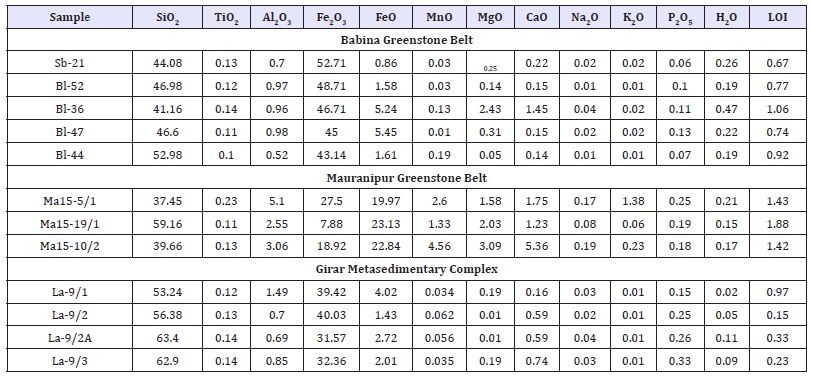
Discussion and Conclusion
The peak of crustal growth, emplacement of komatiitestholeiite assemblage, greenstone development, and deposition of BIF was maximum during Neoarchaean time in Indian shield [23]. But the Bundelkhand craton contain Meso- and Neoarchean supracrustal (greenstone and metasedimentary) complexes, common occurrences with BIFs in central and southern part in these complexes. Two Mesoarchean BIF assemblages are distinguished in the Central Bundelkhand complex: one in the Babina and the other in the Mauranipur Greenstone Belts (GBs). The BIF assemblages of Babina and Mauranipur GBs has tectonic contacts with basic-ultrabasic and felsic volcanic assemblages [1,8]. The Neoarchean BIF of the south Bundelkhand craton is part of stratigraphic seqences and lay on quartzite and dolomites. The iron formation of the Mauranipur GB commonly occurs with Mnamphibole- magnetite quartzite.
Correlation with Karelian Craton
The biggest BIF deposits of the Karelian Craton are in the Archean (2.84-2.78Ga) Kostomuksha GB. BIF is represented by magnetitic, gruneritic-magnetitic and riebeckitic-magnetitic quartzites. Major BIF ore bodies occur among graded schists (metamorphosed sandy-clay flysch), but they are also encountered among basalt-komatiite and rhyolite-dacite assemblages [24,25]. The BIF of the Bundelkhand craton is subdivided into three geochemical types: high-Mn (Mauranipur GB), high-Cr (Girar GB) and low- Ni (Babina GB). The high-Mn BIF of the Mauranipur GB differs from others in very high MnO concentration (0.92-4.82%) and high Al2O3, CaO, MgO, Zr, Y, Rb, Nb, Ba, Ti, ΣREE, Tl, Te, Ni. Such a composition indicates that the sediments were probably formed in a backarc basin in which both terrigenous and hydrothermal material was supplied. The BIF from the Babina GB shows an entirely different composition: it is poor in Al2O3, CaO, Na2O, Ni, V and Cr and has a high Co/Ni ratio. This BIF was formed presumably in a fore-arc basin with high hydrothermal activity [8]. The BIF of the Girar GB differs from the rest in relatively high Cr, Ni, U, Ag and Bi, low Al2O3, CaO, Ti and ΣREE and extremely high variations in SiO2 and Fe. These BIFs seem to have been formed in a basin with high hydrothermal activity far from terrigenous source areas.
The BIF of the Kostomuksha GB of the Karelian craton displays high Al2O3, CaO, MgO, Na2O, TiO2, Ni, Cu and Zn concentrations and is very similar to the BIF of the Mauranipur GB but without extreme Mn concentrations. This BIF was probably formed in a fore-arc basin supplied with terrigenous material. Thus, the composition of BIF is a sensitive indicator of geodynamic settings. The BIF occur with metamorphosed basalts, lesser andesite basalts, metakomatiites, volcano-clastic rocks of greenstone belts in Mauranipur and Babina area in the Bundelkhand region which took place during Mesoarchean (ca. 2813Ma; [9]) time and the basaltic rocks were formed in a subduction geodynamic setting. In the Babina and Mauranipur region some basic and high-Mg rocks are formed in an ensimatic island-arc to subduction and plume (oceanic plateau) geodynamic setting, as indicated by their composition [1]. BIF must have also been formed in the fore-arc basin of an island-arc system. The ocean was not completely closed along the central Bundelkhand region in the Mesoarchean time. The ca. 2.56-2.54Ga felsic volcanics of Central Bundelkhand Greenstone Complex were formed in an active continent margin environment. The oceanic were close ca. 2.52-2.51Ga and large suture in the central portion of the craton were formed. The detail studies require for upgrade the beneficiating plant with new technology and make the economical use for the low grade iron ores deposits from different parts of India.
Acknowledgement
The work was supported by DST, Gov. of India, New Delhi (project no. SR/S4/ES-339/2008), DST-ILTP (project no. INT/ ILTP/B-2.72) and is continue under DST-RFBR (INT/RUS/ RFBR/P-279 and RFBR-17-55-45005 IND) grants. This work is also supporting under MOU between Bundelkhand University, Jhansi, India and Institute of Geology, Karelian Research Centre, RAS, Petrozavodsk, Russia.
References
- Singh VK, Slabunov A (2014) The Central Bundelkhand Archaean Greenstone belt, Bundelkhand craton, Central India: geology, composition, and geochronology of supracrustal rocks. International Geology Review 57: 1349-1364.
- Basu AK (1986) Geology of parts of Bundelkhand granite massif, Central India. Rec Geol Surv India 117: 61-124.
- Sarkar A, Paul DK, Potts PJ (1996) Geochronology and geochemistry of the Mid-Archean, Trondhjemitic gneisses from the Bundelkhand craton, Central India, In: Saha AK (Ed.), Recent Researches in Geology 16: 76-92.
- Ramakrishnan M, Vaidyanadhan R (2010) Geology of India. Geological Society of India 1: 556.
- Sharma KK, Rahman A (2000) The Early Archean-Palaeoproterozoic crustal growth of the Bundelkhand Craton, Northern Indian Shield. In: Dev M (Ed.), Crustal Evolution and Metallogeny in the Northwestern Indian Shield, pp. 51-72
- Patil S, Nishad RK, Seena MS, Singh VK (2007) Palaeomagnetic, rock magnetic and low field AMS investigations on the Proterozoic dykes of Bundelkhand Craton: Constraints on their age and mode of emplacement mechanism, in International Association of Geodesy, IUGG General Assembly, Italy, p. 3053.
- Singh VK, Slabunov AI (2016) Two types of Archaean supracrustal belts in the Bundelkhand Craton, India: geology, geochemistry, age and implication for craton crustal evolution. Journal of the Geological Society of India 88(5): 539-548.
- Singh VK, Slabunov A (2015b) Geochemical characteristics of Banded Iron Formation and Metavolcanics from Babina greenstone belt of the Bundelkhand Craton, Central India. Journal of Economic Geology and Georesource Management 10: 63-74.
- Singh VK, Slabunov AI (2013) The Greenstone belts of the Bundelkhand craton, Central India: New geochronological data and geodynamic setting, In: Singh VK, Chandra R, (Eds.), International Association for Gondwana Research Conference 3rd International conference Precambrian Continental Growth and Tectonism, Jhansi, India, pp. 170- 171.
- Slabunov A, Singh VK, Joshi KB, Li X (2017) Paleoarchean zircons from quartzite of South Bundelkhand Supracrustal Complex: Origin and implications for crustal evolution in Bundelkhand Craton, Central India. Current Science 112(4): 794-801.
- Zainuddin SM, Mondal MEA (1998) Trends of Arc maturity in subduction related Bundelkhand batholith of central India, In: Paliwal BS (Ed.), Indian Precambrian, Scientific Publishers (India), Jodhpur, India, pp. 73- 80.
- Mondal MEA, Zainuddin SM (1997) Geochemical characteristics of the granites of Bundelkhand massif, Central India. J Geol Soc India 50(1): 69-74.
- Malviya VP, Arima M, Pati JK, Kaneko Y (2006) Petrology and geochemistry of metamorphosed basaltic pillow lava and basaltic komatiite in the Mauranipur area: Subduction related volcanism in the Archean Bundelkhand craton, Central India. J Mineral Petrol Science 101: 199-217.
- Singh MM, Singh VK (2011) Geochemistry and tectonic setting of the TTG-gneiss and granite from central part of the Bundelkhand craton, India. In: Singh VK, Ram C (Eds.) Proceeding of the 2nd International Conference Precambrian Continental Growth and Tectonism, Angel Publication, New Delhi, India, pp. 95-102.
- Slabunov AI, Singh VK (2018) Crustal evolution of Bundelkhand craton (Indian Shield) in the Meso-Neoarchean time: New data from greenstone belts, IGR (submitted).
- Slabunov АI, Singh VK (2017) Central Bundelkhand greenstone complex of the Bundelkhand Craton, India: new geochronological data, a geodynamic setting and the position of the craton in the Kenorland Supercontinent structure. In: Slabunov AI, Svetov SA, Baltibaev Sh K(Eds.), Extended Abstracts and Field Trips Guide. Petrozavodsk, KarRC RAS, Russia, pp. 235-238.
- Singh PK, Verma SK, Moreno JA, Singh VK, Oliveira EP, et al. (2018) Geochemistry and Sm-Nd isotope systematics of basalt from the Babina and Mauranipur (central Bundelkhand greenstone complex): Implication for the Paleoarchean mantle evolution and tectonic setting, Precambrian Research (submitted).
- Prakash R, Swarup P, Srivastva RN (1975) Geology and Mineralization in Southern Parts of Bundelkhand in Lalitpur District, UP. Jour Geol Soc India 16(2): 143-156.
- Farooqui SA, Singh PK (2010) PGE Mineralisation in Ultramafic/Mafic enclaves of Ikauna area, In: Satake K (Ed.), Advances in Geosciences 20: 111-120.
- Slabunov A, Egorova S, Singh VK, Svetov S, Kumar S (2018) Archean mafic-ultramafic Ikauna layered intrusion, Bundelkhand craton, India: petrography and geochemistry. In: Singh VK (Ed.), Earth Crust Evolution: from Precambrian to Recent, pp. 93-102.
- Mondal MEA, Goswami JN, Deomurari MP, Sharma KK (2002) Ion microprobe 207Pb/206Pb ages of zircon from the Bundelkhand massif, northern India: Implication for crustal evolution of Bundelkhand - Aravalli protocontinent. Precambrian Research 117(1-2): 85-100.
- Verma SK, Verma SP, Oliveira EP, Singh VK, Moreno JA (2016) LA-SFICP- MS zircon U-Pb geochronology of granitic rocks from the central Bundelkhand greenstone complex, Bundelkhand craton, India. Journal of Asian Earth Sciences 118: 125-137.
- Naqvi SM (2005) Geology and Evolution of the Indian Plate (from Hadean to Holocene - 4Ga to 4Ka), Capital Publishing Company, New Delhi, India, p. 450.
- Gorkovets V Ya, Rayevskaya МB, Volodichev ОI, Golovanova LS (1991) Geology and metamorphism of the iron-cherty formations of Karelia. p. 176.
- Gorkovets V Ya, Sharov NV (2015) Kostomuksha Ore Province: Geology, deep structure and mineralogeny. Petrozavodsk: Karelian Research Centre, RAS, p. 322.
© 2018 Singh VK. This is an open access article distributed under the terms of the Creative Commons Attribution License , which permits unrestricted use, distribution, and build upon your work non-commercially.
 a Creative Commons Attribution 4.0 International License. Based on a work at www.crimsonpublishers.com.
Best viewed in
a Creative Commons Attribution 4.0 International License. Based on a work at www.crimsonpublishers.com.
Best viewed in 







.jpg)






























 Editorial Board Registrations
Editorial Board Registrations Submit your Article
Submit your Article Refer a Friend
Refer a Friend Advertise With Us
Advertise With Us
.jpg)






.jpg)














.bmp)
.jpg)
.png)
.jpg)










.jpg)






.png)

.png)



.png)






